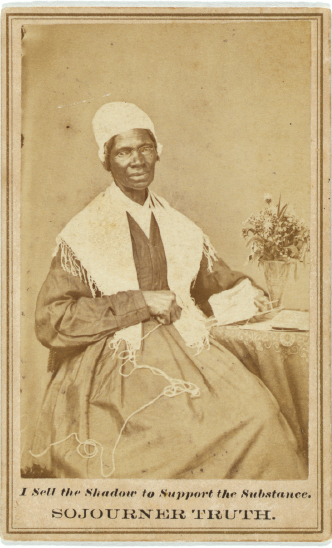Allusion
An allusion is making a vague or indirect reference to people, historical events, or concepts that an audience will recognize in order to give deeper meaning to the message and possibly evoke emotional responses. Allusions can also provide grounded context that goes beyond what you are saying directly. In Truth’s “Ain’t I a Woman?” speech, for example, she uses allusion with the words “If the first woman God ever made was strong enough to turn the world upside down all alone, these women together ought to be able to turn it back, and get it right side up again.” She is alluding to the biblical figure Eve, who ate the forbidden fruit from the tree of the knowledge of good and evil, and upset the harmonious balance between God and humankind. Truth does not take time to explain this story; she knows that her audience will understand her reference and uses allusion to add power and emotion to her message.
SAMPLE SPEECH 13.1
Ain’t I a Woman?
SOJOURNER TRUTH

Well, children, where there is so much racket there must be something out of kilter. I think that ’twixt the negroes of the South and the women at the North, all talking about rights, the white men will be in a fix pretty soon. But what’s all this here talking about?
That man over there says the women need to be helped into carriages, and lifted over ditches, and to have the best place everywhere. Nobody ever helps me into carriages, or over mud-
Notice how Truth encourages the audience to extend this existing belief about women to her, as she too is a woman.
Then they talk about this thing in the head; what’s this they call it? [member of the audience whispers “intellect”] That’s it, honey. What’s that got to do with women’s rights or negroes’ rights? If my cup won’t hold but a pint, and yours holds a quart, wouldn’t you be mean not to let me have my little half measure full?
Then that little man in black there, he says women can’t have as much rights as men, ’cause Christ wasn’t a woman! Where did your Christ come from? Where did your Christ come from? From God and a woman! Man had nothing to do with Him.
If the first woman God ever made was strong enough to turn the world upside down all alone, these women together ought to be able to turn it back, and get it right side up again. And now they is asking to do it, the men better let them.
Truth invokes religious stories that are familiar to the audience members in her effort to persuade them.
Obliged to you for hearing me, and now old Sojourner ain’t got nothing more to say.
Source: From Sojourner Truth, “Ain’t I a Woman?” speech delivered at the Women’s Convention in Akron, Ohio, May 1851. Retrieved from http:/